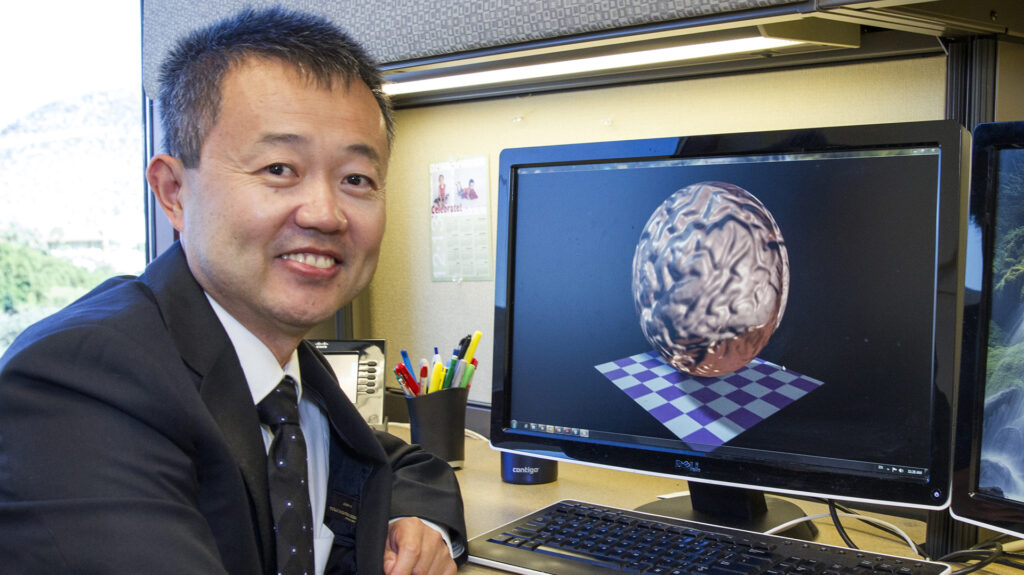Myopia, also known as myopia, is on the rise, especially among children.
Experts predict that by 2050, myopia will affect approximately 50% of the world’s population. Researchers believe that an increase in what is called “near work» – when we interact with nearby objects like phones and screens – is partly to blame.
For many people, difficulty seeing distant objects is a problem easily solved with glasses or contact lenses, but for others it develops into a much more serious condition called myopic maculopathy.
A team of researchers in the School of Computer Science and Augmented Intelligencepart of the Ira A. Fulton Schools of Engineering at Arizona State University, is developing new diagnostic tools that use the power of artificial intelligence, or AI, to more effectively screen for this disease. They recently published the results of their work in the peer-reviewed research journal JAMA Ophthalmology.
Myopic maculopathy occurs when the part of the eye that helps us see straight ahead in precise detail is stretched and damaged. Over time, the shape of the eye changes to become elongated, looking more like a football than a sphere. When this happens, vision is distorted.
This serious illness is the leading cause of severe vision loss or blindness. In 2015, myopic maculopathy led to visual impairment in 10 million people. If things don’t change, more than 55 million people will suffer from vision loss and around 18 million people worldwide will become blind from the disease by 2050.
Since myopic maculopathy is irreversible, experts want to intervene early. Detecting this disease as early as possible can improve health outcomes, a particularly urgent goal when children are affected. Ophthalmologists may prescribe special contact lenses or eye drops that slow the progression of the disease.
Yalin Wangprofessor of computer science and engineering at the Fulton Schools, says technological innovations can provide important solutions.
“AI is paving the way for a revolution that harnesses global knowledge to improve the accuracy of diagnostics, particularly in the early stages of disease,” he says. “These advances will reduce medical costs and improve the quality of life of entire societies. »

Professor Wang at work in his office. The School of Computing and Augmented Intelligence researcher and his team have published a series of articles in the peer-reviewed research journal JAMA Ophthalmology that describe their innovative projects. Photographer: Nora Skrodenis/ASU
A challenge to see things in a new way
In response to this need, the Medical image computing and computer-assisted intervention companyor company MICCAI, has launched a challenge in 2023. The professional organization that seeks to drive innovation in biomedical research has asked experts to improve computer-assisted screening systems for retinal images.
Currently, myopic maculopathy is diagnosed using optical coherence tomograms which use reflected light to create images of the back of the eye. These exams are then often manually inspected by an ophthalmologist, a time-consuming process that may require specialized experience.
Wang and his team in the Geometric Systems Laboratory answered the call. The researchers were among the winners of the MICCAI challenge.
For the first part of the work, Wang and his team, which includes Wenhui Zhu, a doctoral student in computer engineering, as well as a neurologist and adjunct faculty member from the Fulton schools. Dr Oana Dumitrascudiscussed the classification of myopic maculopathy. The disease has five classifications that describe its severity. Determining the correct level helps ophthalmologists provide more tailored and effective solutions to the patient.
Fulton Schools researchers have created new AI algorithms called NN-MobileNet. These sets of instructions that computer programs follow to do their work are designed to help software analyze retinal images more efficiently and predict the correct classification of myopic maculopathy.
Next, the team turned its attention to efforts in the scientific community to use a type of AI called deep neural networks to predict the spherical equivalent in retinal scans. The spherical equivalent is an estimate of the refractive error that doctors need when prescribing glasses or contact lenses. In deep neural networks, researchers task computers with analyzing huge data sets and apply AI-based algorithms to draw useful conclusions.
With a more precise measurement of spherical equivalent, doctors can make more precise treatment recommendations. So, Wang and the team again developed new algorithms focused on data quality and relevance. Their new retinal image analysis model achieved exceptional results while minimizing the necessary computing power. The results of this research were also published in JAMA Ophthalmology.
Finally, Wang collaborated with other MICCAI challenge winning teams on a third research paper, published in JAMA Ophthalmology in Septemberwho presented the collected results. Researchers from universities around the world have made their results available to spur additional advances and discoveries in the early and effective diagnosis of myopic maculopathy and improve health care outcomes for people across the world.
A better vision of global health
Wang says one of the motivations behind her work is to solve health disparities.
“People living in rural areas have difficulty accessing sophisticated imaging machines and seeing doctors,” he says. “Once AI-based technology becomes available, it will significantly improve the quality of life for people around the world, including those living in developing countries. »
Ross Maciejewskidirector of the School of Computing and Augmented Intelligence, says Wang’s project is an important example of the excellent work being done by faculty members in the medical field.
“With myopia and myopic maculopathy on the rise, solutions are needed to prevent vision loss and help healthcare professionals provide the best treatment options for their patients,” says Maciejewski. “Yalin Wang’s innovative research is based on the rational use of artificial intelligence to solve this serious medical problem. »


